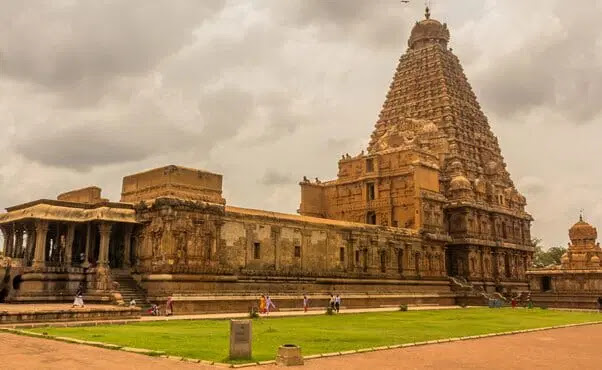Thanjavur, often hailed as the "Rice Bowl of Tamil Nadu," is a district with a rich cultural heritage and a long-standing legacy. Known for its historical landmarks, Thanjavur is home to some of the most famous and breathtaking palaces in India. These palaces are not only architectural marvels but also a testament to the powerful dynasties that ruled the region. If you're planning a trip to Tamil Nadu, don’t miss exploring these iconic palaces in Thanjavur, where history, art, and architecture come together.
1. Thanjavur Maratha Palace
One of the most famous landmarks in Thanjavur, the Thanjavur Maratha Palace (also called the Thanjavur Palace or Royal Palace Complex), is a masterpiece that showcases the Maratha dynasty’s contributions to South Indian architecture. Built in the 16th century by the Nayakas and later renovated by the Marathas, this palace stands as a symbol of Thanjavur's royal past.
Location: Near Thanjavur Railway Station
Key Highlights:
The Saraswathi Mahal Library: One of Asia’s oldest libraries, this library holds a vast collection of palm-leaf manuscripts, historical documents, and ancient texts.
Art Gallery: The Raja Raja Chola Art Gallery is a treasure trove of bronze and stone statues, depicting the rich artistry of the Chola dynasty.
Sangeetha Mahal: An acoustically perfect hall used for cultural events and music performances, reflecting the Maratha kings' patronage of the arts.
The Thanjavur Maratha Palace is a must-visit for history enthusiasts and architecture lovers. This palace captures the essence of Thanjavur’s regal splendor and is one of the most famous tourist palaces in Tamil Nadu.
2. Sivaganga Fort and Palace
Another popular attraction, the Sivaganga Fort and Palace, lies within Thanjavur and showcases a different side of the district's architectural beauty. This fort was built by the Chola rulers and later modified by the Nayaks and Marathas, serving as a stronghold to protect Thanjavur from invasions.
Location: Near Thanjavur’s Big Temple (Brihadeeswarar Temple)
Key Highlights:
The Sivaganga Garden: A lush green area with fountains and a pond that creates a serene environment, perfect for relaxing after exploring the fort.
The Water Tank: Known for its historical irrigation system, it is a marvel of ancient engineering.
Museum: A small museum within the fort complex displays a collection of weaponry, artifacts, and memorabilia from Thanjavur’s royal past.
3. Pudukkottai Palace
While technically located in the Pudukkottai district, this palace is easily accessible from Thanjavur and is often included in the Thanjavur tourist itinerary. The Pudukkottai Palace, built in the 17th century, is a classic example of the grand lifestyle of the Tamil Nadu royalty.
Location: Approximately 40 km from Thanjavur
Key Highlights:
The Durbar Hall: With intricate paintings and designs, the hall was used for royal gatherings and is now a popular spot for photography.
Galleries: Art galleries within the palace exhibit rare artifacts, weaponry, and regalia that provide insights into the history of Pudukkottai's rulers.
Architecture: The palace features a mix of Dravidian and European architectural styles, with elaborate carvings and murals that are a delight for architecture buffs.
Pudukkottai Palace offers a royal experience away from the usual crowd, making it one of the best palaces near Thanjavur to explore.
4. Rajah Serfoji Memorial Hall
The Rajah Serfoji Memorial Hall is not a palace in the traditional sense but is dedicated to the memory of the Maratha King Serfoji II. This hall highlights the contributions of the Maratha dynasty to Thanjavur’s cultural and educational landscape.
Location: Within the Thanjavur Maratha Palace complex.
Key Highlights:
Life and Works of Serfoji II: The museum within the hall showcases artifacts, paintings, and books associated with the life of Serfoji II.
Historical Paintings: Visitors can see beautiful artworks depicting the Maratha rule in Thanjavur.
Legacy: Serfoji II’s contributions to literature, education, and the arts are celebrated here, making this hall an important cultural landmark.
If you are interested in learning about Thanjavur’s historical figures, the Rajah Serfoji Memorial Hall offers a fascinating glimpse into the Maratha influence on Thanjavur’s cultural evolution.
5. The Brihadeeswarar Temple Complex
While technically not a palace, no trip to Thanjavur would be complete without a visit to the Brihadeeswarar Temple Complex, a UNESCO World Heritage Site. Built by Raja Raja Chola I, this temple stands as a symbol of Chola architecture and devotion to Lord Shiva.
Location: Thanjavur city center
Key Highlights:
The Gopuram: Standing tall at over 200 feet, it is one of the tallest temple towers in the world.
Nandi Statue: A colossal statue of Nandi (the bull mount of Lord Shiva) greets visitors at the entrance, symbolizing the temple’s grandeur.
Temple Murals: The inner walls are adorned with intricate murals and carvings that depict stories from Hindu mythology.
The Brihadeeswarar Temple, also known as the “Big Temple,” is a testament to the artistic and architectural genius of the Chola dynasty. It remains one of Thanjavur’s most iconic landmarks and draws tourists from around the world.
Thanjavur is not just a city of temples but a district steeped in royal heritage. Each palace and fort in this region tells the story of a bygone era and showcases the rich history and culture of Tamil Nadu. From the Thanjavur Maratha Palace to the iconic Brihadeeswarar Temple, the palaces in Thanjavur provide an unforgettable experience for every visitor. So, if you’re a history enthusiast or just someone looking for a culturally enriching experience, Thanjavur should be at the top of your travel list.





